Seabury Grandin Quinn (1889-1969) was a lawyer and journalist/editor who is best known to the pulp world today as the author of the occult detective Jules de Grandin.
Overlooked by most are his many pulp works before and alongside his de Grandin stories. While there are over 90 stories in the de Grandin series, now collected in five hardcover books, he wrote several other, shorter series, as well as many stand-along works.
There are the “Washington Nights’ Entertainment” series, or Major Sturdevant series, which ran 24 stories; the Professor Forrester series of 13 stories; the HIJI (Captain Sir Haddingway Ingraham Jameson Ingraham) series of 16 stories; and a few others. His other works have been reprinted by the Battered Silicon Dispatch Box, but these are hard to get ahold of. And while they plan on reprinting the Sturdevant, Forrester, and HIJI stories, I am not clear if they have done so.
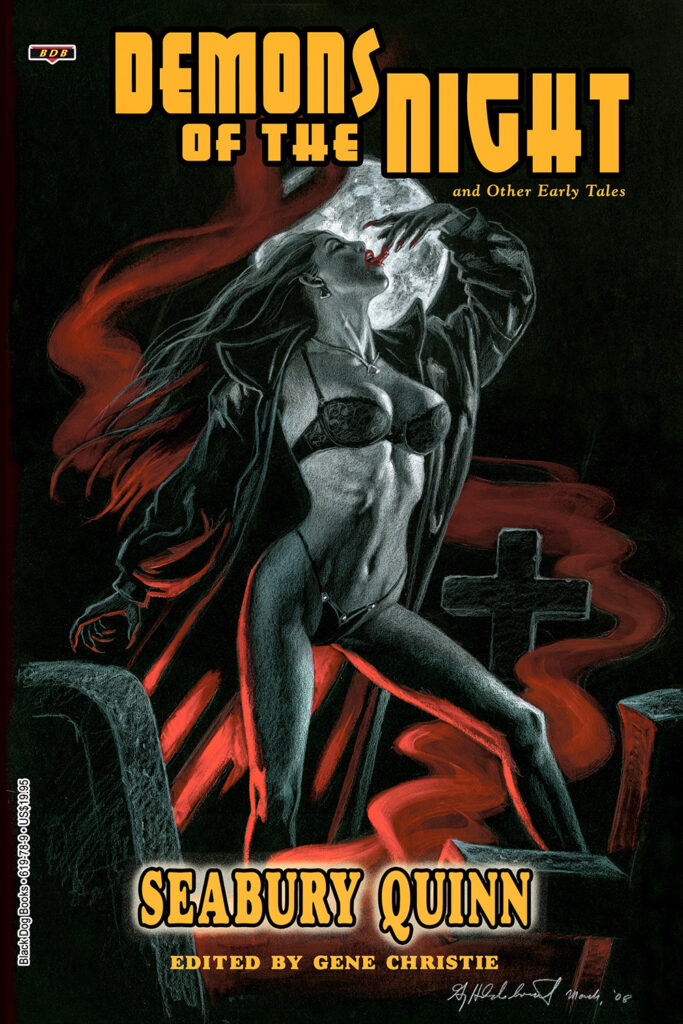 Thankfully, two collections from Black Dog Books help addresses that to a degree. Both are edited by Gene Christie.
Thankfully, two collections from Black Dog Books help addresses that to a degree. Both are edited by Gene Christie.
While they make no attempt at reprinting all his non-de Grandin work, they show a lot of this other work. Maybe this will lead to more complete and accessible collections.
First up is Demons of the Night, and Other Early Tales (2009), which contains the following:
- “Demons of the Night,” Detective Story Magazine (March 19, 1918)
- “Was She Mad?” Detective Story Magazine (June 25, 1918)
- “The Stone Image,” The Thrill Book (May 1, 1919)
- “Painted Gold,” Young’s Magazine (May 1919)
- “The Cloth of Madness,” Young’s Magazine (January 1920)
- “Romance Unawares,” Young’s Magazine (September 1920)
- “Ravished Shrines,” Real Detective Tales and Mystery Stories (July 1925; Major Sturdevant)
- “Out of the Land of Egypt,” Real Detective Tales and Mystery Stories (August/September 1926; Major Sturdevant)
- “In a Fog,” Real Detective Tales and Mystery Stories (February 1927; Professor Forrester)
- “The Black Widow,” Real Detective Tales and Mystery Stories (January 1928; Professor Forrester)
The first stories are kind of weird mysteries. The first deals with vampires, written when vampires in stories weren’t that common. I thought it interesting that “The Stone Image” included a character named Dr. Towbridge. Was this an inspiration for the later Dr. Trowbrige who helped de Grandin?
There also includes Quinn’s first published article, “The Law of the Movies” (Motion Picture Magazine, December 1917), and his first fiction sale, “Demons of the Night.” We also get samples of two other long series of stories that ran in Real Detective Tales. These are his “Major Sturdevant” and the “Professor Forrester” series.
Real Detective Tales started as Detective Tales published by Rural Publishing in 1922, which soon launched Weird Tales! Then the company split, at which point, Detective Tales was renamed Real Detective Tales. The Major Sturdevant series ran from 1923 to 1926 for 24 stories, and Professor Forrester replaced him from 1927 to 1929 for 12 stories.
While both are detective series and, surprisingly, both set in Washington, D.C., they are non-standard, which I guess we should suspect of the creator of Jules de Grandin. Interesting, the same police inspector from the Major Sturdevant stories shows up in at least the first Professor Forrester story.
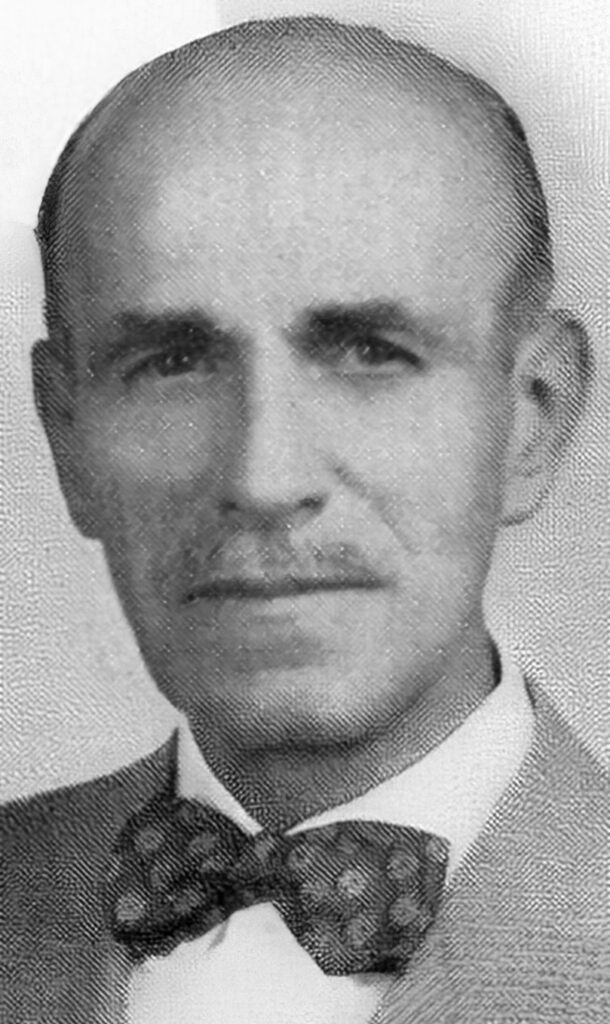
Major Sturdevant does not appear to be a detective. He has ties to foreign service agents of both the U.S. and other countries, and he’s an investigator of some sort, may be some kind of spy or government agent. He’s white-haired with a white beard and mustache, and his stories are narrated by Frank Loomis, a reporter for a local paper. The series is called the “Washington Nights’ Entertainment,” and I have no idea for the basis for this name.
We get two stories from the series, one later in the series, plus the last one. Both are strange mysteries tied to dangerous foreign agents. In the first, a series of thefts of religious objects occurs in the U.K. and now the U.S. Who is behind this? Major Sturdevant gets involved at the request of an English bishop. In the second, Loomis gets pulled into a bizarre exchange of papers to a foreign character by a mysterious Egyptian woman, with some involvement of a British agent and the Major.
Professor Forrester is the head of anthropology at the fictional Benjamin Franklin University. Along with his ward, Rosalie Osterhault, he also gets involved in strange cases. This time we get the first story, along with another toward the end of the series. This first story introduces the Professor and shows how he met his ward. She was born of an American father in the Philippines, but sold into slavery by a Filipino relative. She is brought to Washington by an Asian crime lord where the Professor stumbles upon her and this criminal. The Professor is able to rescue her and help get the criminal arrested. She now becomes his ward.
The second story is about a sinister and mysterious mummy who causes the death of a few people. What is behind this, and can the Professor figure it out before there are more victims?
I certainly would have like to see more of these two series.
Also included is a bibliography of Quinn, as of the publication of this book in 2009. There are some gaps, due to the difficulty of finding certain issues. But I think they’ve been addressed, as I was able to find complete information on Galactic Central. If you’re curious as to what is in various reprints of Quinn’s stories up to 2009, this is shown.
 Next we have Someday I’ll Kill You, and Other Forgotten Stories (2017), which contains stories outside of Weird Tales between 1925 and 1963.
Next we have Someday I’ll Kill You, and Other Forgotten Stories (2017), which contains stories outside of Weird Tales between 1925 and 1963.
These are broken down into different groups. We also get both stories in the Black Wolf series, but I was disappointed that neither volume had any examples of the HIJI series, especially as they appeared in Jungle Stories, and we get other stories published in that pulp.
The stories in this volume, grouped by their themes, include:
Tales of the Fantastic and Supernatural
- “The Lesser Brethren Mourn,” Strange Tales (October 1940)
- “Doomed,” Strange Tales (December 1940)
- “Someday I’ll Kill You!” Strange Stories (February 1941)
- “Candid Camera,” Thrilling Mystery (May 1941)
- “I Married a Ghost,” Thrilling Mystery (July 1941)
- “Fate Rolls the Bones,” Thrilling Adventures (January 1942)
- “Bewitchment,” Thrilling Mystery (July 1942)
- “Dead Man’s Shoes,” 5 Detective Novels Magazine (Winter 1951)
- “Master Nicholas,” Mirage (1964)
These stories are like what you’d expect from Weird Tales. Christie speculates that the editors solicited these stories. First is a trio from Strange Tales a rival of WT.
In “The Lesser Brethren Mourn,” a Civil War vetern dies, with only an uncaring nephew as family. After the veteran is laid out in a coffin, the narrator, a mortician’s apprentice, sees the lesser brethren of the title mourning his death. In “Doomed,” a man about to take a two-week vacation meets a young lady, and they spend his vacation together. At the end, he realizes he doesn’t know her name when he sees her picture in the paper and realized who she is. “Someday I’ll Kill You!” is a strange love triangle. A married couple who have known each other since they were born is torn apart by “another woman.” After the wife dies, she settles up.
Next are tales that ran in various Standard/Thrilling magazines. In “Candid Camera,” an amateur photographer has an encounter with a strange man, who causes him to make a change in his career that has a sinister end. In “I Married a Ghost,” a columnist attends a seance that goes array. But he meet a strange girl there that he later marries before he realizes who, or what, she really is. “Fate Rolls the Bones” is about an American adventurer in Indian being haunted by the ghost of an old companion until death. Or was it all delirium? “Bewitchment” has a Union soldier from the Civil War finding himself in modern Brooklyn, and dies of old age as a “john doe” when he breaks a promise he shouldn’t have. A former Russian peasent, now living in New York, finds himself blackmailed in “Dead Man’s Shoes”. He finally take actions, but for the dead man’s shoes, might have gotten away with it. Finally, in “Master Nicholas” someone purchases a journal from the 1600s and recounts the strange tale within involving the author, an Eliab Mothersole and Master Nicholas.
Stories of Mystery and Suspense
- “An Innocent Bystander,” Detective Stories (Aug. 1, 1925)
- “Shanghai in Manhattan,” Thrilling Adventures (September 1941)
- “The Ghost Hunters,” Short Stories (Oct. 25, 1941)
- “A Matter of Protocol,” Short Stories (Dec. 10, 1942)
- “The Man Who Hated Cats,” Short Stories (December 1950)
These stories are more mystery tales, without any supernatural element. “An Innocent Bystander” is about a ship passenger, who through kindness, gets pulled into some criminal activities. “Shanghai in Manhattan” actually starts in Shanghai with some strange characters before shifting to New York. It makes use of a reporter who also appears in “The Ghost Hunters.” In that tale, the reporter, who is dealing with a female rival, finds himself at a party at a house with an apparent ghost. Can he and the girl he mets figure out what going on? And can he scoop his rival?
The final two stories are a short tale that turns out to be a little, espionage story, and a strange crime tale with some interesting twists.
Four from the Jungle
- “If Two Are Dead—” Jungle Stories (Winter 1949/50)
- “Congo Fury,” Jungle Stories (Winter 1950/51)
- “Brands from the Burning,” Jungle Stories (Winter 1951/52)
- “Great Caesar,” Short Stories (January 1951)
All these tales are, of course, set in “the jungle,” whether in Africa or someplace else. In “If Two Are Dead,” after the death of a village chief in west central Africa, his eldest son becomes the next chief. But his brother is jealous. This leads to a conspiracy, which, as we know, three people have a secret that will be kept if two are dead. In “Great Caesar,” a minor stage magician leaves town after accidentally killing a man. Making his way to Africa, he departs for the interior where he make a place for himself. The others are similar tales.
The Adventures of the Black Wolf
- “The Black Wolf Prowls,” Short Stories (Feb. 10, 1944)
- “Revolt in Paradise,” Short Stories (April 25, 1944)
The Black Wolf is an interesting, if short series. It reminded me right off of Zorro, but there are several differences. Set in California around the 1820s-30s, the Black Wolf is a highwayman who operates in the area of San Francisco Bay. He wears a black-and-silver outfit, uses many weapons (pistols, sword, etc), and rides a black mount. He had done several daring crimes, and recently killed the suitor for a girl he desired. After that, she decides to instead become a nun and heads to a nearby convent. When the Black Wolf appears, saves her and escorts her there, we learn his story, and that he hadn’t killed anyone. Someone else has been doing this. And his story is very different from Zorro.
The second story has him save a revolutionary, and he may return to help them make California a free republic. But we never got any other stories. It’s too bad, as this was a good series.
For those wanting to read more of Quinn’s works beyond just Jules de Grandin, both of these collections are excellent. I hope to read his other series soon.

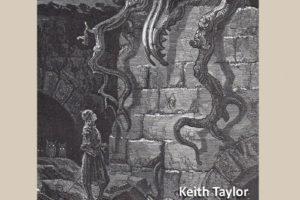
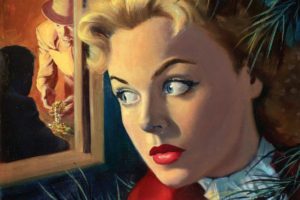
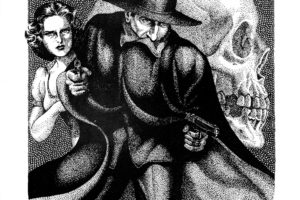
Your comments